Preparing Final Accounts for Sole Traders and Partnerships Analysis
VerifiedAdded on 2020/12/29
|22
|4995
|252
Report
AI Summary
This report provides a comprehensive overview of final accounts for sole traders and partnerships. It starts by outlining the reasons for closing accounts and preparing a trial balance, explaining the processes and limitations of producing final accounts from a trial balance, and describing techniques for preparing accounts from incomplete records. The report then delves into practical applications, including computing opening and closing capital and cash/bank balances, producing sales and purchase ledger control accounts, and measuring balances using markups and margins. Detailed components of final accounts for a sole trader, including the profit or loss statement and statement of financial position, are presented. The report then discusses the components of partnership agreements and accounts, producing profit or loss appropriation accounts, determining profit allocation, and preparing current and capital accounts for partners. Finally, the report includes the computation of closing balances on capital and current accounts for partners and the production of the statement of financial position, concluding with a summary of the key takeaways and references.
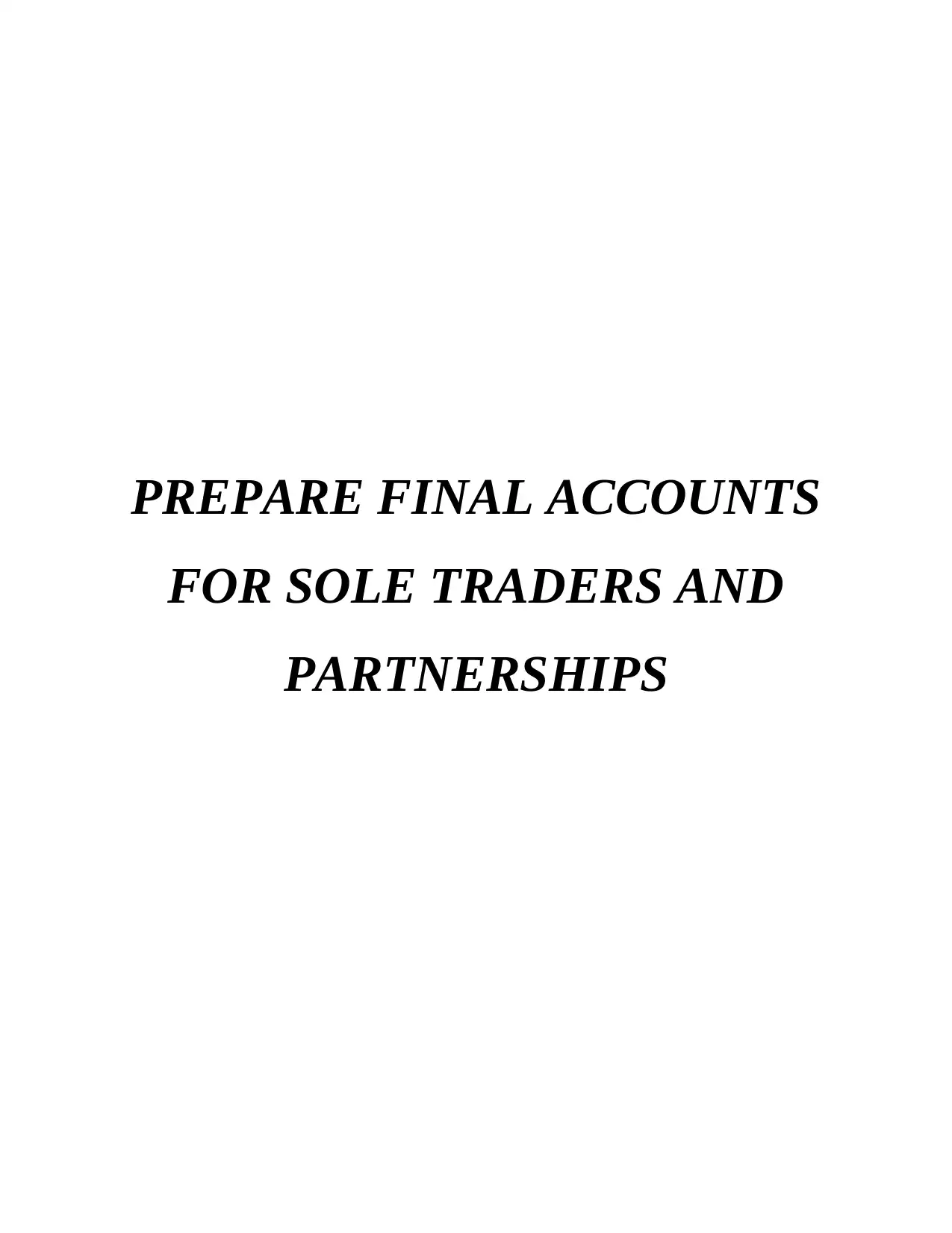
PREPARE FINAL ACCOUNTS
FOR SOLE TRADERS AND
PARTNERSHIPS
FOR SOLE TRADERS AND
PARTNERSHIPS
Paraphrase This Document
Need a fresh take? Get an instant paraphrase of this document with our AI Paraphraser
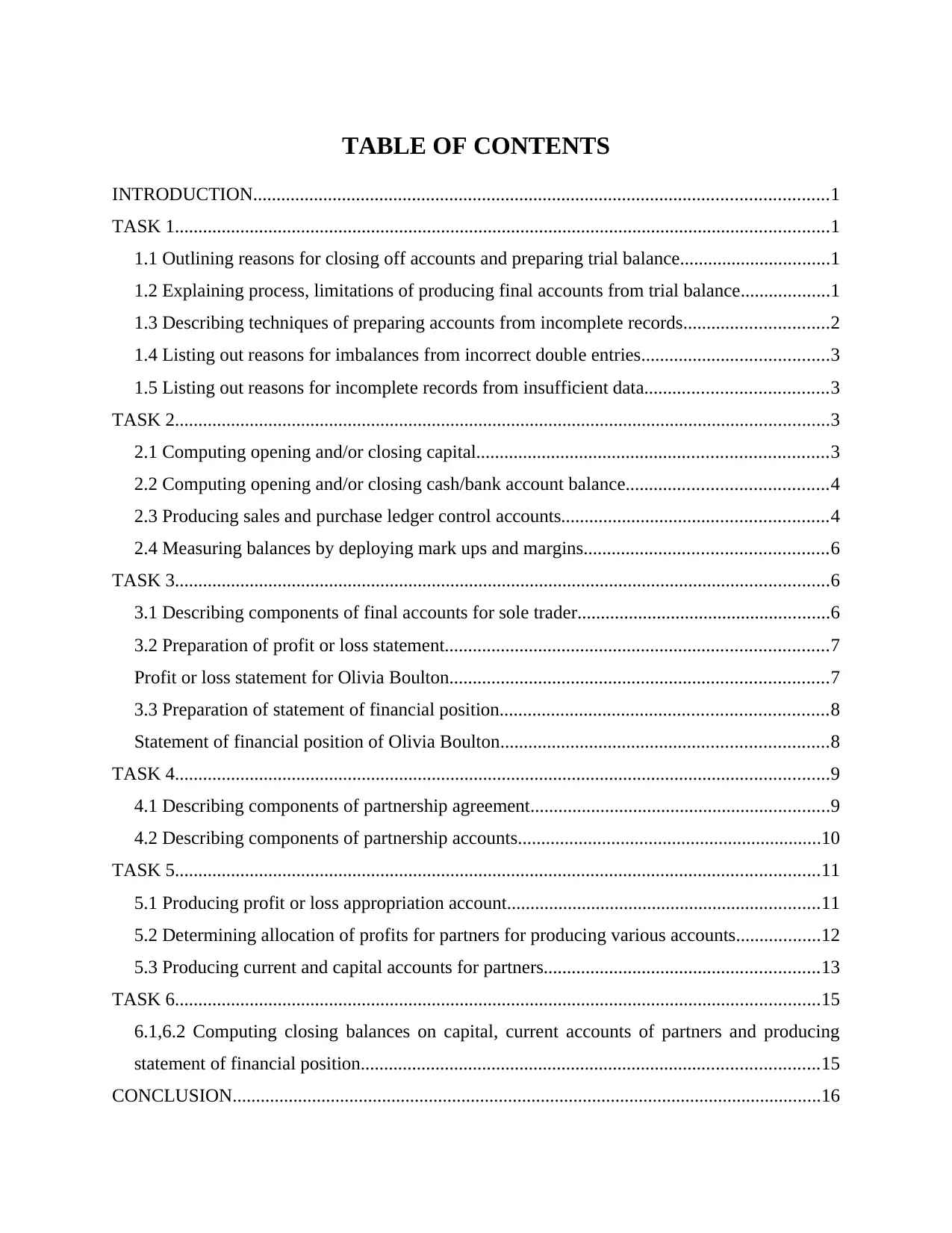
TABLE OF CONTENTS
INTRODUCTION...........................................................................................................................1
TASK 1............................................................................................................................................1
1.1 Outlining reasons for closing off accounts and preparing trial balance................................1
1.2 Explaining process, limitations of producing final accounts from trial balance...................1
1.3 Describing techniques of preparing accounts from incomplete records...............................2
1.4 Listing out reasons for imbalances from incorrect double entries........................................3
1.5 Listing out reasons for incomplete records from insufficient data.......................................3
TASK 2............................................................................................................................................3
2.1 Computing opening and/or closing capital...........................................................................3
2.2 Computing opening and/or closing cash/bank account balance...........................................4
2.3 Producing sales and purchase ledger control accounts.........................................................4
2.4 Measuring balances by deploying mark ups and margins....................................................6
TASK 3............................................................................................................................................6
3.1 Describing components of final accounts for sole trader......................................................6
3.2 Preparation of profit or loss statement..................................................................................7
Profit or loss statement for Olivia Boulton.................................................................................7
3.3 Preparation of statement of financial position......................................................................8
Statement of financial position of Olivia Boulton......................................................................8
TASK 4............................................................................................................................................9
4.1 Describing components of partnership agreement................................................................9
4.2 Describing components of partnership accounts.................................................................10
TASK 5..........................................................................................................................................11
5.1 Producing profit or loss appropriation account...................................................................11
5.2 Determining allocation of profits for partners for producing various accounts..................12
5.3 Producing current and capital accounts for partners...........................................................13
TASK 6..........................................................................................................................................15
6.1,6.2 Computing closing balances on capital, current accounts of partners and producing
statement of financial position..................................................................................................15
CONCLUSION..............................................................................................................................16
INTRODUCTION...........................................................................................................................1
TASK 1............................................................................................................................................1
1.1 Outlining reasons for closing off accounts and preparing trial balance................................1
1.2 Explaining process, limitations of producing final accounts from trial balance...................1
1.3 Describing techniques of preparing accounts from incomplete records...............................2
1.4 Listing out reasons for imbalances from incorrect double entries........................................3
1.5 Listing out reasons for incomplete records from insufficient data.......................................3
TASK 2............................................................................................................................................3
2.1 Computing opening and/or closing capital...........................................................................3
2.2 Computing opening and/or closing cash/bank account balance...........................................4
2.3 Producing sales and purchase ledger control accounts.........................................................4
2.4 Measuring balances by deploying mark ups and margins....................................................6
TASK 3............................................................................................................................................6
3.1 Describing components of final accounts for sole trader......................................................6
3.2 Preparation of profit or loss statement..................................................................................7
Profit or loss statement for Olivia Boulton.................................................................................7
3.3 Preparation of statement of financial position......................................................................8
Statement of financial position of Olivia Boulton......................................................................8
TASK 4............................................................................................................................................9
4.1 Describing components of partnership agreement................................................................9
4.2 Describing components of partnership accounts.................................................................10
TASK 5..........................................................................................................................................11
5.1 Producing profit or loss appropriation account...................................................................11
5.2 Determining allocation of profits for partners for producing various accounts..................12
5.3 Producing current and capital accounts for partners...........................................................13
TASK 6..........................................................................................................................................15
6.1,6.2 Computing closing balances on capital, current accounts of partners and producing
statement of financial position..................................................................................................15
CONCLUSION..............................................................................................................................16

REFERENCES..............................................................................................................................17
⊘ This is a preview!⊘
Do you want full access?
Subscribe today to unlock all pages.

Trusted by 1+ million students worldwide
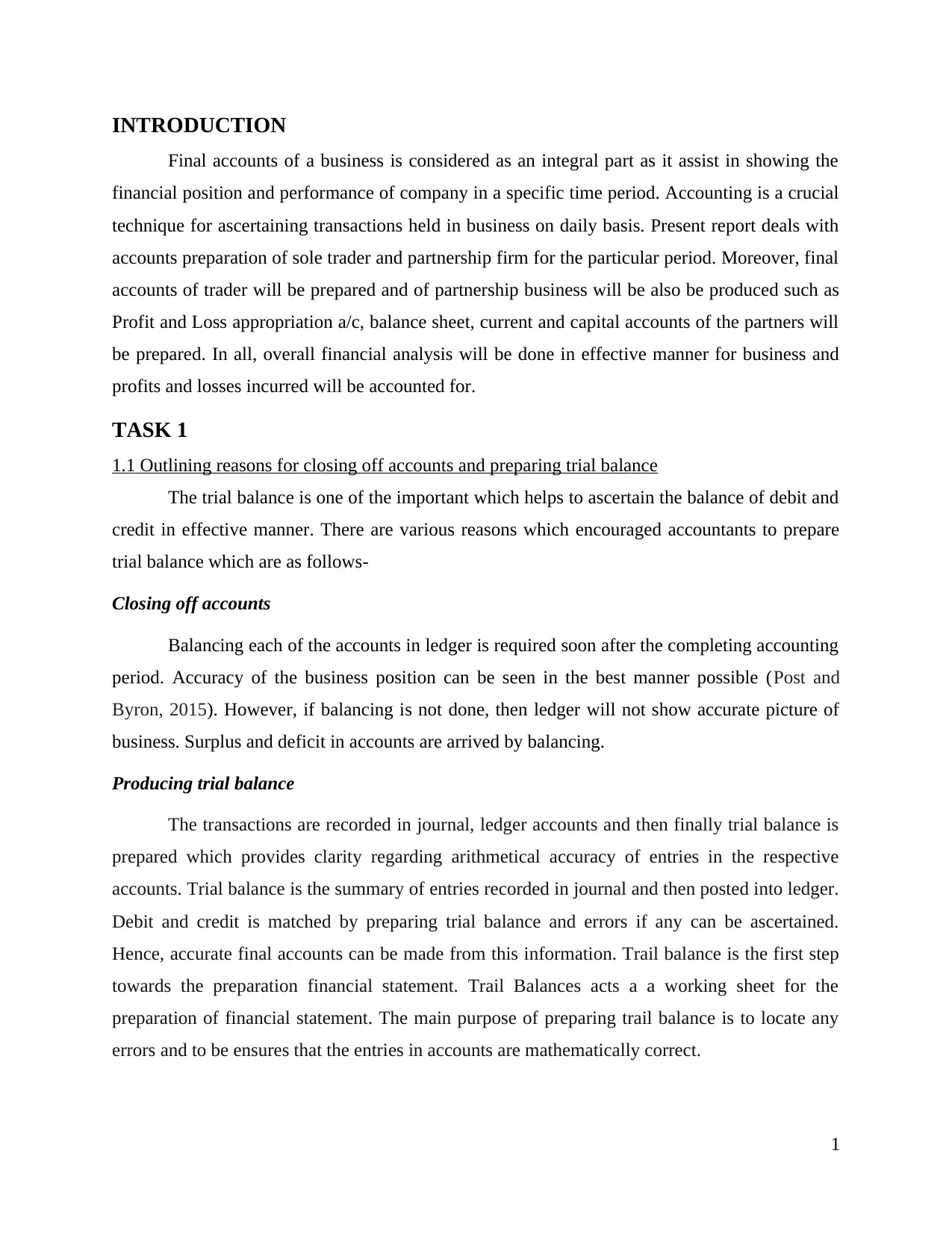
INTRODUCTION
Final accounts of a business is considered as an integral part as it assist in showing the
financial position and performance of company in a specific time period. Accounting is a crucial
technique for ascertaining transactions held in business on daily basis. Present report deals with
accounts preparation of sole trader and partnership firm for the particular period. Moreover, final
accounts of trader will be prepared and of partnership business will be also be produced such as
Profit and Loss appropriation a/c, balance sheet, current and capital accounts of the partners will
be prepared. In all, overall financial analysis will be done in effective manner for business and
profits and losses incurred will be accounted for.
TASK 1
1.1 Outlining reasons for closing off accounts and preparing trial balance
The trial balance is one of the important which helps to ascertain the balance of debit and
credit in effective manner. There are various reasons which encouraged accountants to prepare
trial balance which are as follows-
Closing off accounts
Balancing each of the accounts in ledger is required soon after the completing accounting
period. Accuracy of the business position can be seen in the best manner possible (Post and
Byron, 2015). However, if balancing is not done, then ledger will not show accurate picture of
business. Surplus and deficit in accounts are arrived by balancing.
Producing trial balance
The transactions are recorded in journal, ledger accounts and then finally trial balance is
prepared which provides clarity regarding arithmetical accuracy of entries in the respective
accounts. Trial balance is the summary of entries recorded in journal and then posted into ledger.
Debit and credit is matched by preparing trial balance and errors if any can be ascertained.
Hence, accurate final accounts can be made from this information. Trail balance is the first step
towards the preparation financial statement. Trail Balances acts a a working sheet for the
preparation of financial statement. The main purpose of preparing trail balance is to locate any
errors and to be ensures that the entries in accounts are mathematically correct.
1
Final accounts of a business is considered as an integral part as it assist in showing the
financial position and performance of company in a specific time period. Accounting is a crucial
technique for ascertaining transactions held in business on daily basis. Present report deals with
accounts preparation of sole trader and partnership firm for the particular period. Moreover, final
accounts of trader will be prepared and of partnership business will be also be produced such as
Profit and Loss appropriation a/c, balance sheet, current and capital accounts of the partners will
be prepared. In all, overall financial analysis will be done in effective manner for business and
profits and losses incurred will be accounted for.
TASK 1
1.1 Outlining reasons for closing off accounts and preparing trial balance
The trial balance is one of the important which helps to ascertain the balance of debit and
credit in effective manner. There are various reasons which encouraged accountants to prepare
trial balance which are as follows-
Closing off accounts
Balancing each of the accounts in ledger is required soon after the completing accounting
period. Accuracy of the business position can be seen in the best manner possible (Post and
Byron, 2015). However, if balancing is not done, then ledger will not show accurate picture of
business. Surplus and deficit in accounts are arrived by balancing.
Producing trial balance
The transactions are recorded in journal, ledger accounts and then finally trial balance is
prepared which provides clarity regarding arithmetical accuracy of entries in the respective
accounts. Trial balance is the summary of entries recorded in journal and then posted into ledger.
Debit and credit is matched by preparing trial balance and errors if any can be ascertained.
Hence, accurate final accounts can be made from this information. Trail balance is the first step
towards the preparation financial statement. Trail Balances acts a a working sheet for the
preparation of financial statement. The main purpose of preparing trail balance is to locate any
errors and to be ensures that the entries in accounts are mathematically correct.
1
Paraphrase This Document
Need a fresh take? Get an instant paraphrase of this document with our AI Paraphraser
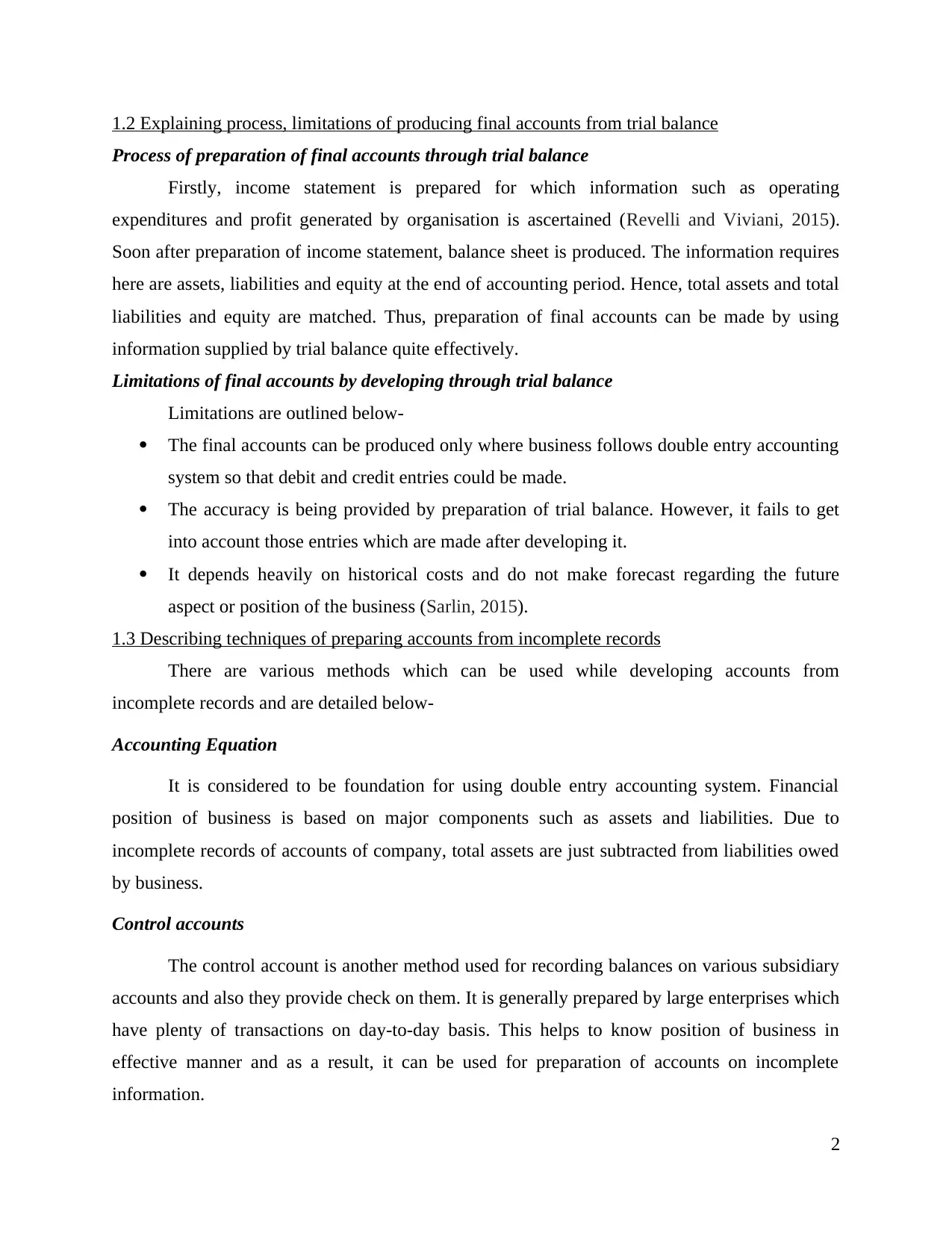
1.2 Explaining process, limitations of producing final accounts from trial balance
Process of preparation of final accounts through trial balance
Firstly, income statement is prepared for which information such as operating
expenditures and profit generated by organisation is ascertained (Revelli and Viviani, 2015).
Soon after preparation of income statement, balance sheet is produced. The information requires
here are assets, liabilities and equity at the end of accounting period. Hence, total assets and total
liabilities and equity are matched. Thus, preparation of final accounts can be made by using
information supplied by trial balance quite effectively.
Limitations of final accounts by developing through trial balance
Limitations are outlined below-
The final accounts can be produced only where business follows double entry accounting
system so that debit and credit entries could be made.
The accuracy is being provided by preparation of trial balance. However, it fails to get
into account those entries which are made after developing it.
It depends heavily on historical costs and do not make forecast regarding the future
aspect or position of the business (Sarlin, 2015).
1.3 Describing techniques of preparing accounts from incomplete records
There are various methods which can be used while developing accounts from
incomplete records and are detailed below-
Accounting Equation
It is considered to be foundation for using double entry accounting system. Financial
position of business is based on major components such as assets and liabilities. Due to
incomplete records of accounts of company, total assets are just subtracted from liabilities owed
by business.
Control accounts
The control account is another method used for recording balances on various subsidiary
accounts and also they provide check on them. It is generally prepared by large enterprises which
have plenty of transactions on day-to-day basis. This helps to know position of business in
effective manner and as a result, it can be used for preparation of accounts on incomplete
information.
2
Process of preparation of final accounts through trial balance
Firstly, income statement is prepared for which information such as operating
expenditures and profit generated by organisation is ascertained (Revelli and Viviani, 2015).
Soon after preparation of income statement, balance sheet is produced. The information requires
here are assets, liabilities and equity at the end of accounting period. Hence, total assets and total
liabilities and equity are matched. Thus, preparation of final accounts can be made by using
information supplied by trial balance quite effectively.
Limitations of final accounts by developing through trial balance
Limitations are outlined below-
The final accounts can be produced only where business follows double entry accounting
system so that debit and credit entries could be made.
The accuracy is being provided by preparation of trial balance. However, it fails to get
into account those entries which are made after developing it.
It depends heavily on historical costs and do not make forecast regarding the future
aspect or position of the business (Sarlin, 2015).
1.3 Describing techniques of preparing accounts from incomplete records
There are various methods which can be used while developing accounts from
incomplete records and are detailed below-
Accounting Equation
It is considered to be foundation for using double entry accounting system. Financial
position of business is based on major components such as assets and liabilities. Due to
incomplete records of accounts of company, total assets are just subtracted from liabilities owed
by business.
Control accounts
The control account is another method used for recording balances on various subsidiary
accounts and also they provide check on them. It is generally prepared by large enterprises which
have plenty of transactions on day-to-day basis. This helps to know position of business in
effective manner and as a result, it can be used for preparation of accounts on incomplete
information.
2
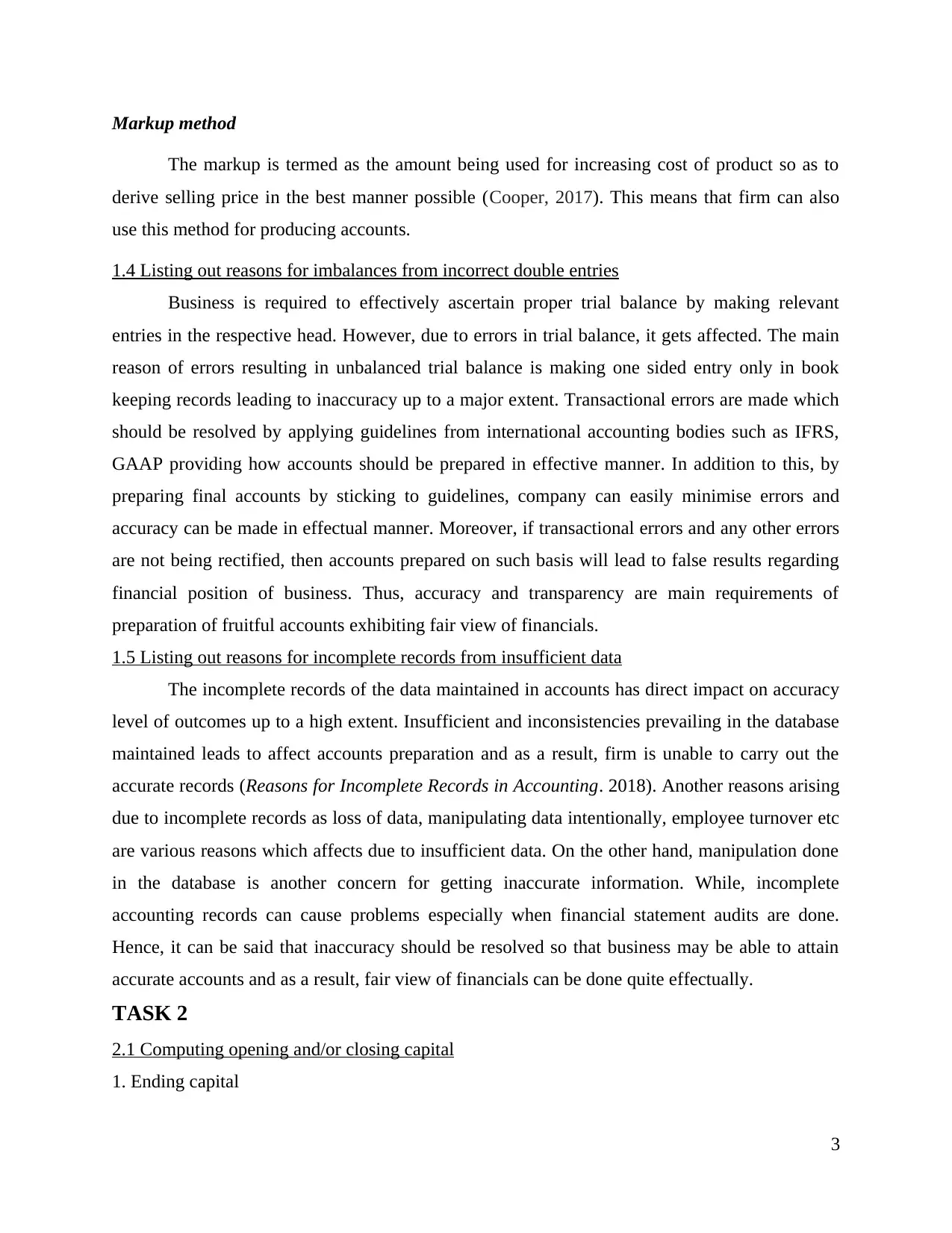
Markup method
The markup is termed as the amount being used for increasing cost of product so as to
derive selling price in the best manner possible (Cooper, 2017). This means that firm can also
use this method for producing accounts.
1.4 Listing out reasons for imbalances from incorrect double entries
Business is required to effectively ascertain proper trial balance by making relevant
entries in the respective head. However, due to errors in trial balance, it gets affected. The main
reason of errors resulting in unbalanced trial balance is making one sided entry only in book
keeping records leading to inaccuracy up to a major extent. Transactional errors are made which
should be resolved by applying guidelines from international accounting bodies such as IFRS,
GAAP providing how accounts should be prepared in effective manner. In addition to this, by
preparing final accounts by sticking to guidelines, company can easily minimise errors and
accuracy can be made in effectual manner. Moreover, if transactional errors and any other errors
are not being rectified, then accounts prepared on such basis will lead to false results regarding
financial position of business. Thus, accuracy and transparency are main requirements of
preparation of fruitful accounts exhibiting fair view of financials.
1.5 Listing out reasons for incomplete records from insufficient data
The incomplete records of the data maintained in accounts has direct impact on accuracy
level of outcomes up to a high extent. Insufficient and inconsistencies prevailing in the database
maintained leads to affect accounts preparation and as a result, firm is unable to carry out the
accurate records (Reasons for Incomplete Records in Accounting. 2018). Another reasons arising
due to incomplete records as loss of data, manipulating data intentionally, employee turnover etc
are various reasons which affects due to insufficient data. On the other hand, manipulation done
in the database is another concern for getting inaccurate information. While, incomplete
accounting records can cause problems especially when financial statement audits are done.
Hence, it can be said that inaccuracy should be resolved so that business may be able to attain
accurate accounts and as a result, fair view of financials can be done quite effectually.
TASK 2
2.1 Computing opening and/or closing capital
1. Ending capital
3
The markup is termed as the amount being used for increasing cost of product so as to
derive selling price in the best manner possible (Cooper, 2017). This means that firm can also
use this method for producing accounts.
1.4 Listing out reasons for imbalances from incorrect double entries
Business is required to effectively ascertain proper trial balance by making relevant
entries in the respective head. However, due to errors in trial balance, it gets affected. The main
reason of errors resulting in unbalanced trial balance is making one sided entry only in book
keeping records leading to inaccuracy up to a major extent. Transactional errors are made which
should be resolved by applying guidelines from international accounting bodies such as IFRS,
GAAP providing how accounts should be prepared in effective manner. In addition to this, by
preparing final accounts by sticking to guidelines, company can easily minimise errors and
accuracy can be made in effectual manner. Moreover, if transactional errors and any other errors
are not being rectified, then accounts prepared on such basis will lead to false results regarding
financial position of business. Thus, accuracy and transparency are main requirements of
preparation of fruitful accounts exhibiting fair view of financials.
1.5 Listing out reasons for incomplete records from insufficient data
The incomplete records of the data maintained in accounts has direct impact on accuracy
level of outcomes up to a high extent. Insufficient and inconsistencies prevailing in the database
maintained leads to affect accounts preparation and as a result, firm is unable to carry out the
accurate records (Reasons for Incomplete Records in Accounting. 2018). Another reasons arising
due to incomplete records as loss of data, manipulating data intentionally, employee turnover etc
are various reasons which affects due to insufficient data. On the other hand, manipulation done
in the database is another concern for getting inaccurate information. While, incomplete
accounting records can cause problems especially when financial statement audits are done.
Hence, it can be said that inaccuracy should be resolved so that business may be able to attain
accurate accounts and as a result, fair view of financials can be done quite effectually.
TASK 2
2.1 Computing opening and/or closing capital
1. Ending capital
3
⊘ This is a preview!⊘
Do you want full access?
Subscribe today to unlock all pages.

Trusted by 1+ million students worldwide
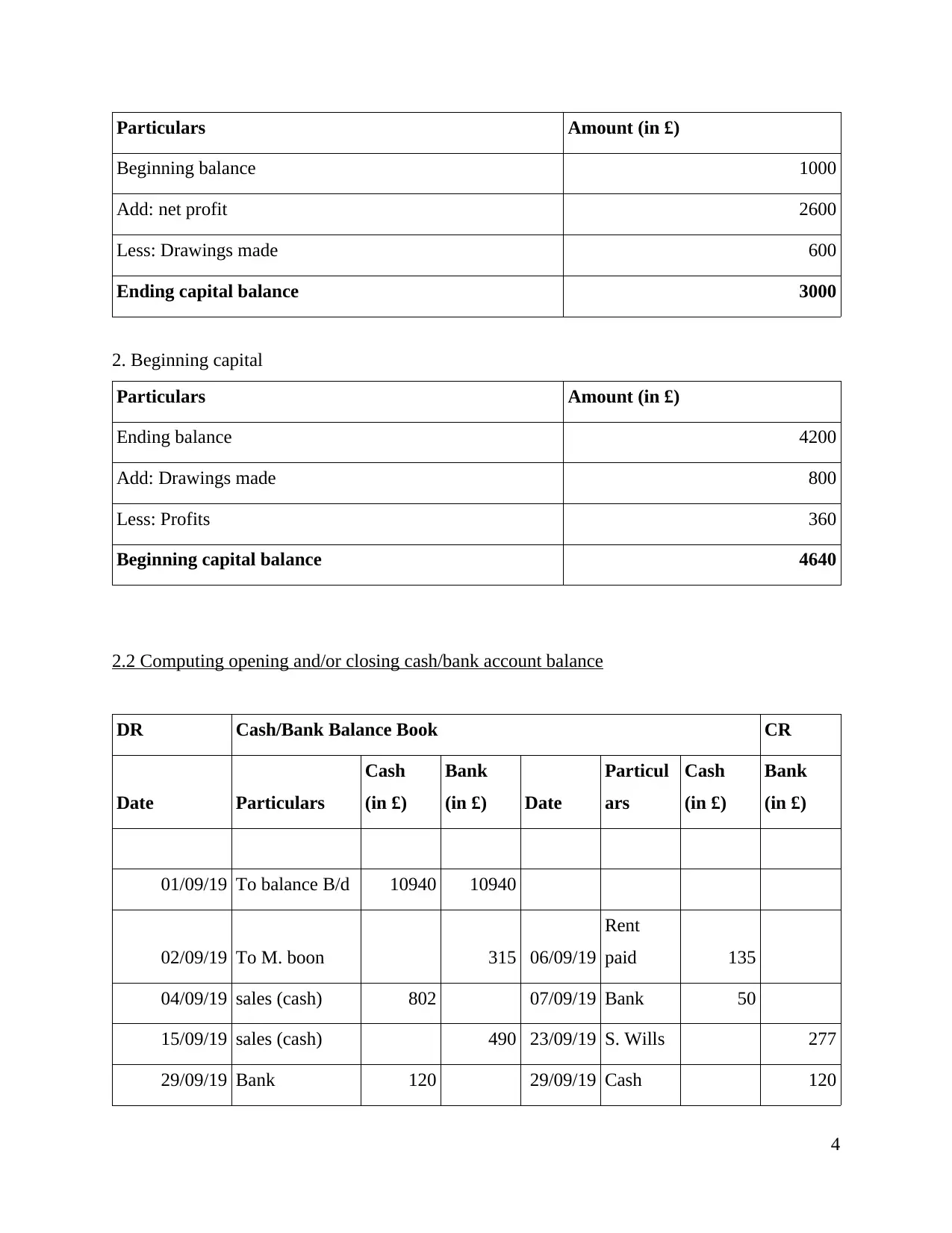
Particulars Amount (in £)
Beginning balance 1000
Add: net profit 2600
Less: Drawings made 600
Ending capital balance 3000
2. Beginning capital
Particulars Amount (in £)
Ending balance 4200
Add: Drawings made 800
Less: Profits 360
Beginning capital balance 4640
2.2 Computing opening and/or closing cash/bank account balance
DR Cash/Bank Balance Book CR
Date Particulars
Cash
(in £)
Bank
(in £) Date
Particul
ars
Cash
(in £)
Bank
(in £)
01/09/19 To balance B/d 10940 10940
02/09/19 To M. boon 315 06/09/19
Rent
paid 135
04/09/19 sales (cash) 802 07/09/19 Bank 50
15/09/19 sales (cash) 490 23/09/19 S. Wills 277
29/09/19 Bank 120 29/09/19 Cash 120
4
Beginning balance 1000
Add: net profit 2600
Less: Drawings made 600
Ending capital balance 3000
2. Beginning capital
Particulars Amount (in £)
Ending balance 4200
Add: Drawings made 800
Less: Profits 360
Beginning capital balance 4640
2.2 Computing opening and/or closing cash/bank account balance
DR Cash/Bank Balance Book CR
Date Particulars
Cash
(in £)
Bank
(in £) Date
Particul
ars
Cash
(in £)
Bank
(in £)
01/09/19 To balance B/d 10940 10940
02/09/19 To M. boon 315 06/09/19
Rent
paid 135
04/09/19 sales (cash) 802 07/09/19 Bank 50
15/09/19 sales (cash) 490 23/09/19 S. Wills 277
29/09/19 Bank 120 29/09/19 Cash 120
4
Paraphrase This Document
Need a fresh take? Get an instant paraphrase of this document with our AI Paraphraser
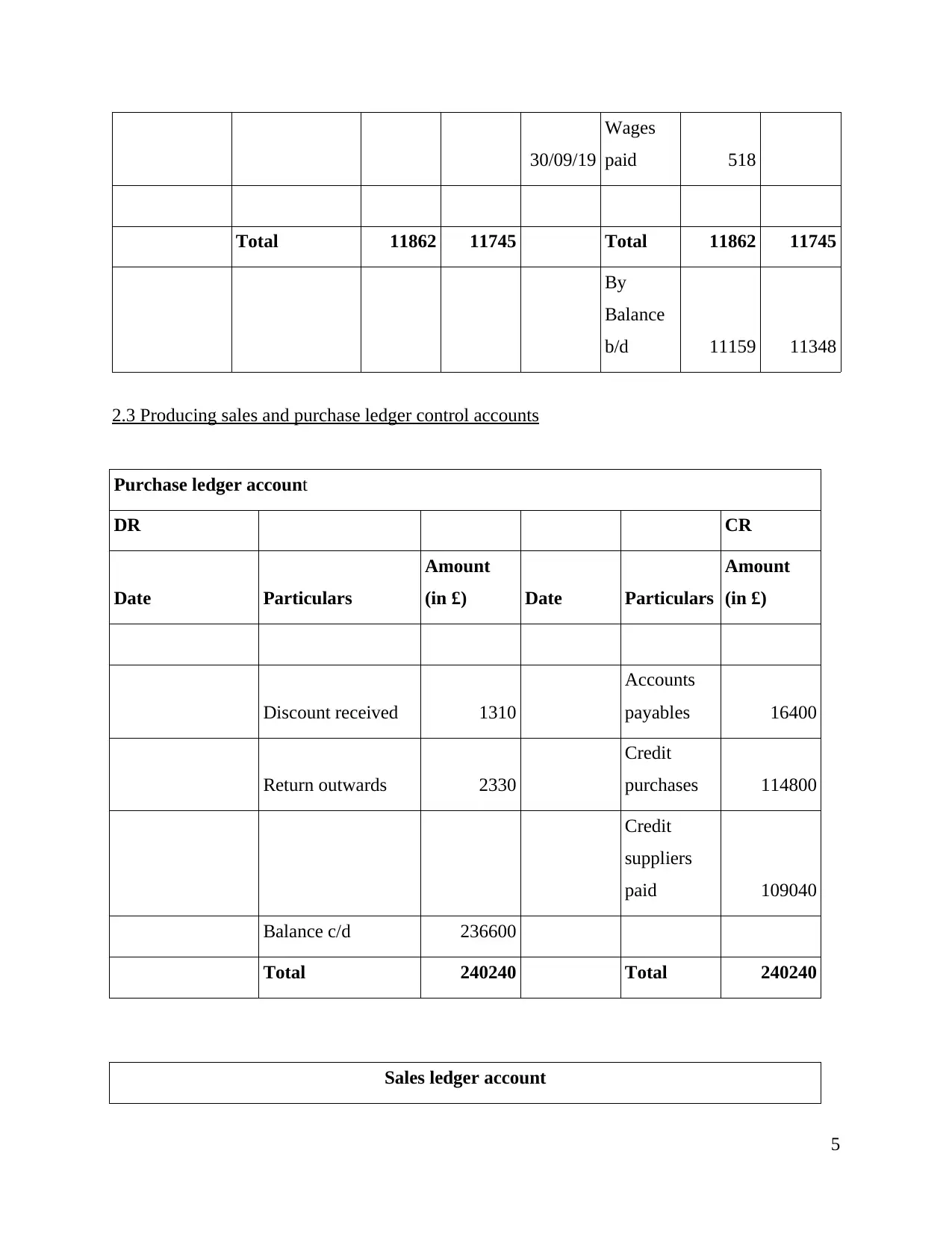
30/09/19
Wages
paid 518
Total 11862 11745 Total 11862 11745
By
Balance
b/d 11159 11348
2.3 Producing sales and purchase ledger control accounts
Purchase ledger account
DR CR
Date Particulars
Amount
(in £) Date Particulars
Amount
(in £)
Discount received 1310
Accounts
payables 16400
Return outwards 2330
Credit
purchases 114800
Credit
suppliers
paid 109040
Balance c/d 236600
Total 240240 Total 240240
Sales ledger account
5
Wages
paid 518
Total 11862 11745 Total 11862 11745
By
Balance
b/d 11159 11348
2.3 Producing sales and purchase ledger control accounts
Purchase ledger account
DR CR
Date Particulars
Amount
(in £) Date Particulars
Amount
(in £)
Discount received 1310
Accounts
payables 16400
Return outwards 2330
Credit
purchases 114800
Credit
suppliers
paid 109040
Balance c/d 236600
Total 240240 Total 240240
Sales ledger account
5
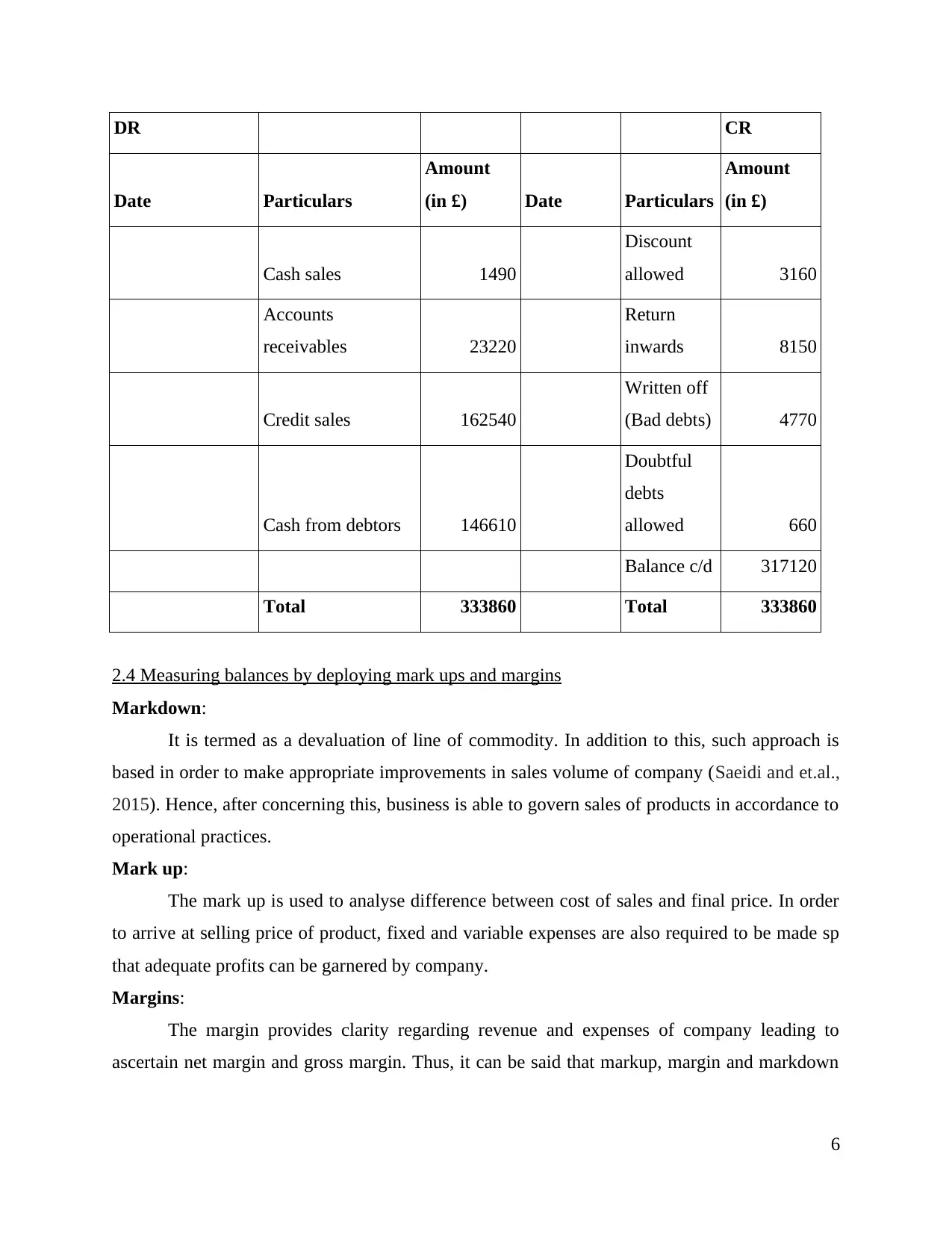
DR CR
Date Particulars
Amount
(in £) Date Particulars
Amount
(in £)
Cash sales 1490
Discount
allowed 3160
Accounts
receivables 23220
Return
inwards 8150
Credit sales 162540
Written off
(Bad debts) 4770
Cash from debtors 146610
Doubtful
debts
allowed 660
Balance c/d 317120
Total 333860 Total 333860
2.4 Measuring balances by deploying mark ups and margins
Markdown:
It is termed as a devaluation of line of commodity. In addition to this, such approach is
based in order to make appropriate improvements in sales volume of company (Saeidi and et.al.,
2015). Hence, after concerning this, business is able to govern sales of products in accordance to
operational practices.
Mark up:
The mark up is used to analyse difference between cost of sales and final price. In order
to arrive at selling price of product, fixed and variable expenses are also required to be made sp
that adequate profits can be garnered by company.
Margins:
The margin provides clarity regarding revenue and expenses of company leading to
ascertain net margin and gross margin. Thus, it can be said that markup, margin and markdown
6
Date Particulars
Amount
(in £) Date Particulars
Amount
(in £)
Cash sales 1490
Discount
allowed 3160
Accounts
receivables 23220
Return
inwards 8150
Credit sales 162540
Written off
(Bad debts) 4770
Cash from debtors 146610
Doubtful
debts
allowed 660
Balance c/d 317120
Total 333860 Total 333860
2.4 Measuring balances by deploying mark ups and margins
Markdown:
It is termed as a devaluation of line of commodity. In addition to this, such approach is
based in order to make appropriate improvements in sales volume of company (Saeidi and et.al.,
2015). Hence, after concerning this, business is able to govern sales of products in accordance to
operational practices.
Mark up:
The mark up is used to analyse difference between cost of sales and final price. In order
to arrive at selling price of product, fixed and variable expenses are also required to be made sp
that adequate profits can be garnered by company.
Margins:
The margin provides clarity regarding revenue and expenses of company leading to
ascertain net margin and gross margin. Thus, it can be said that markup, margin and markdown
6
⊘ This is a preview!⊘
Do you want full access?
Subscribe today to unlock all pages.

Trusted by 1+ million students worldwide
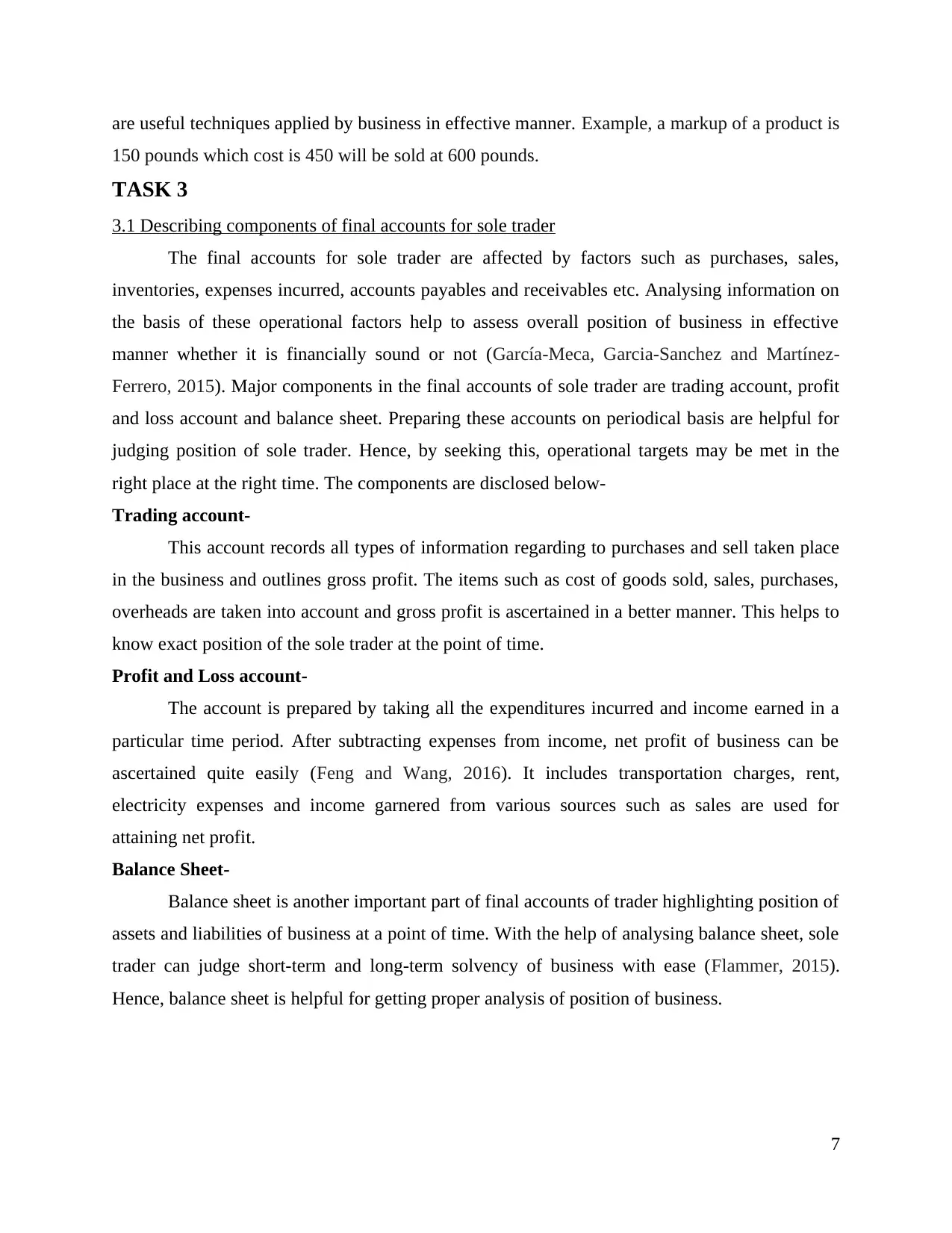
are useful techniques applied by business in effective manner. Example, a markup of a product is
150 pounds which cost is 450 will be sold at 600 pounds.
TASK 3
3.1 Describing components of final accounts for sole trader
The final accounts for sole trader are affected by factors such as purchases, sales,
inventories, expenses incurred, accounts payables and receivables etc. Analysing information on
the basis of these operational factors help to assess overall position of business in effective
manner whether it is financially sound or not (García-Meca, Garcia-Sanchez and Martínez-
Ferrero, 2015). Major components in the final accounts of sole trader are trading account, profit
and loss account and balance sheet. Preparing these accounts on periodical basis are helpful for
judging position of sole trader. Hence, by seeking this, operational targets may be met in the
right place at the right time. The components are disclosed below-
Trading account-
This account records all types of information regarding to purchases and sell taken place
in the business and outlines gross profit. The items such as cost of goods sold, sales, purchases,
overheads are taken into account and gross profit is ascertained in a better manner. This helps to
know exact position of the sole trader at the point of time.
Profit and Loss account-
The account is prepared by taking all the expenditures incurred and income earned in a
particular time period. After subtracting expenses from income, net profit of business can be
ascertained quite easily (Feng and Wang, 2016). It includes transportation charges, rent,
electricity expenses and income garnered from various sources such as sales are used for
attaining net profit.
Balance Sheet-
Balance sheet is another important part of final accounts of trader highlighting position of
assets and liabilities of business at a point of time. With the help of analysing balance sheet, sole
trader can judge short-term and long-term solvency of business with ease (Flammer, 2015).
Hence, balance sheet is helpful for getting proper analysis of position of business.
7
150 pounds which cost is 450 will be sold at 600 pounds.
TASK 3
3.1 Describing components of final accounts for sole trader
The final accounts for sole trader are affected by factors such as purchases, sales,
inventories, expenses incurred, accounts payables and receivables etc. Analysing information on
the basis of these operational factors help to assess overall position of business in effective
manner whether it is financially sound or not (García-Meca, Garcia-Sanchez and Martínez-
Ferrero, 2015). Major components in the final accounts of sole trader are trading account, profit
and loss account and balance sheet. Preparing these accounts on periodical basis are helpful for
judging position of sole trader. Hence, by seeking this, operational targets may be met in the
right place at the right time. The components are disclosed below-
Trading account-
This account records all types of information regarding to purchases and sell taken place
in the business and outlines gross profit. The items such as cost of goods sold, sales, purchases,
overheads are taken into account and gross profit is ascertained in a better manner. This helps to
know exact position of the sole trader at the point of time.
Profit and Loss account-
The account is prepared by taking all the expenditures incurred and income earned in a
particular time period. After subtracting expenses from income, net profit of business can be
ascertained quite easily (Feng and Wang, 2016). It includes transportation charges, rent,
electricity expenses and income garnered from various sources such as sales are used for
attaining net profit.
Balance Sheet-
Balance sheet is another important part of final accounts of trader highlighting position of
assets and liabilities of business at a point of time. With the help of analysing balance sheet, sole
trader can judge short-term and long-term solvency of business with ease (Flammer, 2015).
Hence, balance sheet is helpful for getting proper analysis of position of business.
7
Paraphrase This Document
Need a fresh take? Get an instant paraphrase of this document with our AI Paraphraser
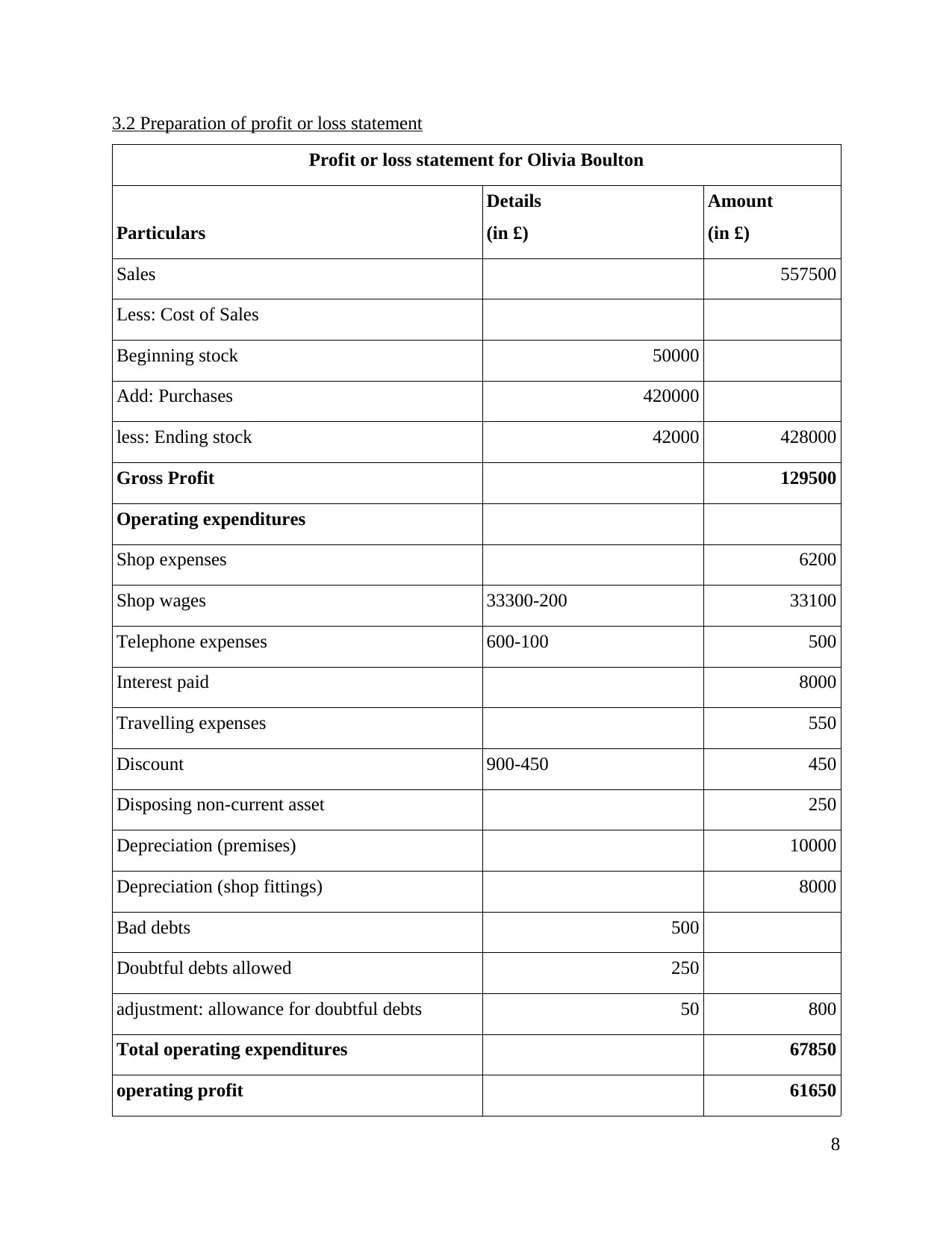
3.2 Preparation of profit or loss statement
Profit or loss statement for Olivia Boulton
Particulars
Details
(in £)
Amount
(in £)
Sales 557500
Less: Cost of Sales
Beginning stock 50000
Add: Purchases 420000
less: Ending stock 42000 428000
Gross Profit 129500
Operating expenditures
Shop expenses 6200
Shop wages 33300-200 33100
Telephone expenses 600-100 500
Interest paid 8000
Travelling expenses 550
Discount 900-450 450
Disposing non-current asset 250
Depreciation (premises) 10000
Depreciation (shop fittings) 8000
Bad debts 500
Doubtful debts allowed 250
adjustment: allowance for doubtful debts 50 800
Total operating expenditures 67850
operating profit 61650
8
Profit or loss statement for Olivia Boulton
Particulars
Details
(in £)
Amount
(in £)
Sales 557500
Less: Cost of Sales
Beginning stock 50000
Add: Purchases 420000
less: Ending stock 42000 428000
Gross Profit 129500
Operating expenditures
Shop expenses 6200
Shop wages 33300-200 33100
Telephone expenses 600-100 500
Interest paid 8000
Travelling expenses 550
Discount 900-450 450
Disposing non-current asset 250
Depreciation (premises) 10000
Depreciation (shop fittings) 8000
Bad debts 500
Doubtful debts allowed 250
adjustment: allowance for doubtful debts 50 800
Total operating expenditures 67850
operating profit 61650
8
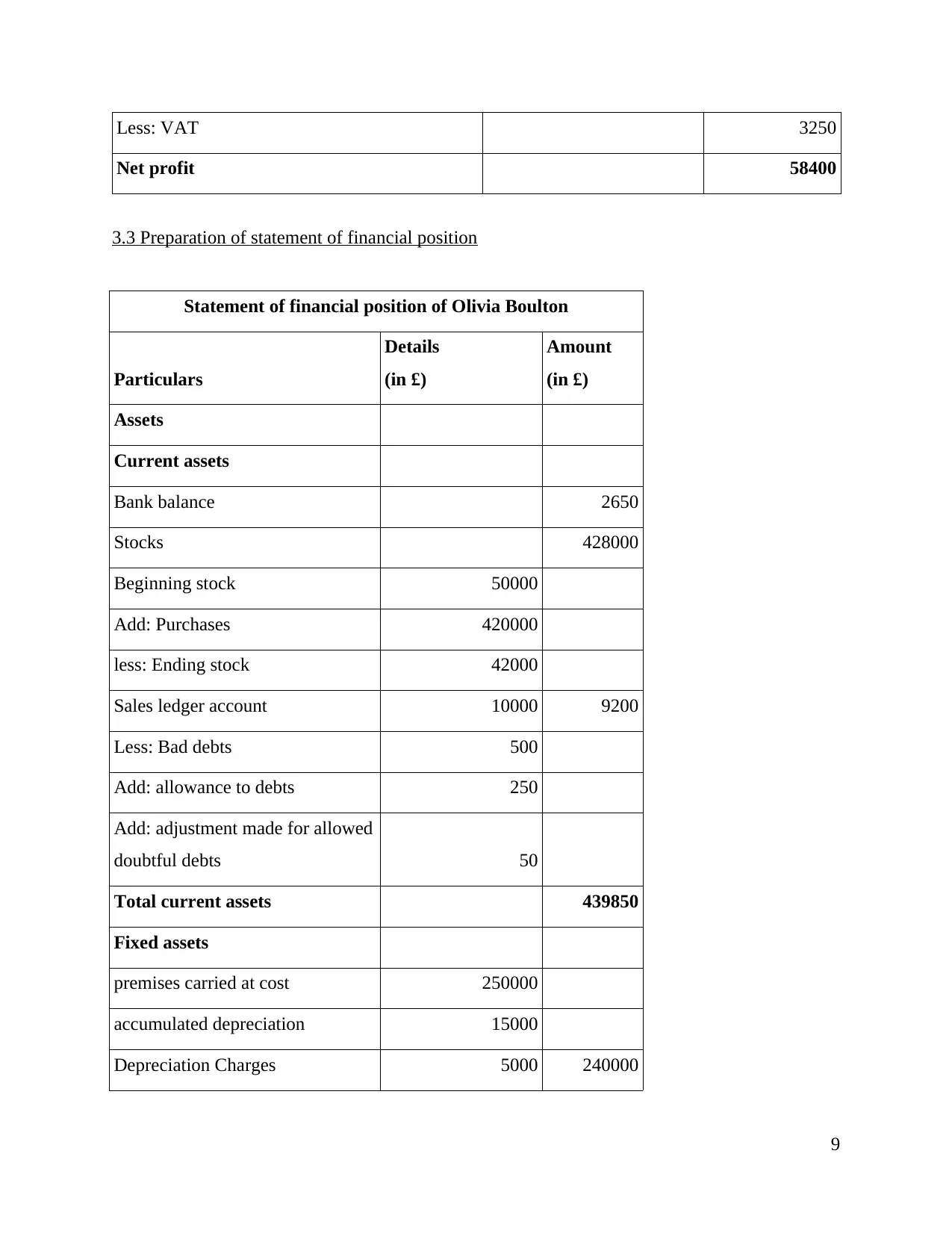
Less: VAT 3250
Net profit 58400
3.3 Preparation of statement of financial position
Statement of financial position of Olivia Boulton
Particulars
Details
(in £)
Amount
(in £)
Assets
Current assets
Bank balance 2650
Stocks 428000
Beginning stock 50000
Add: Purchases 420000
less: Ending stock 42000
Sales ledger account 10000 9200
Less: Bad debts 500
Add: allowance to debts 250
Add: adjustment made for allowed
doubtful debts 50
Total current assets 439850
Fixed assets
premises carried at cost 250000
accumulated depreciation 15000
Depreciation Charges 5000 240000
9
Net profit 58400
3.3 Preparation of statement of financial position
Statement of financial position of Olivia Boulton
Particulars
Details
(in £)
Amount
(in £)
Assets
Current assets
Bank balance 2650
Stocks 428000
Beginning stock 50000
Add: Purchases 420000
less: Ending stock 42000
Sales ledger account 10000 9200
Less: Bad debts 500
Add: allowance to debts 250
Add: adjustment made for allowed
doubtful debts 50
Total current assets 439850
Fixed assets
premises carried at cost 250000
accumulated depreciation 15000
Depreciation Charges 5000 240000
9
⊘ This is a preview!⊘
Do you want full access?
Subscribe today to unlock all pages.

Trusted by 1+ million students worldwide
1 out of 22
Related Documents
Your All-in-One AI-Powered Toolkit for Academic Success.
+13062052269
info@desklib.com
Available 24*7 on WhatsApp / Email
![[object Object]](/_next/static/media/star-bottom.7253800d.svg)
Unlock your academic potential
Copyright © 2020–2025 A2Z Services. All Rights Reserved. Developed and managed by ZUCOL.





